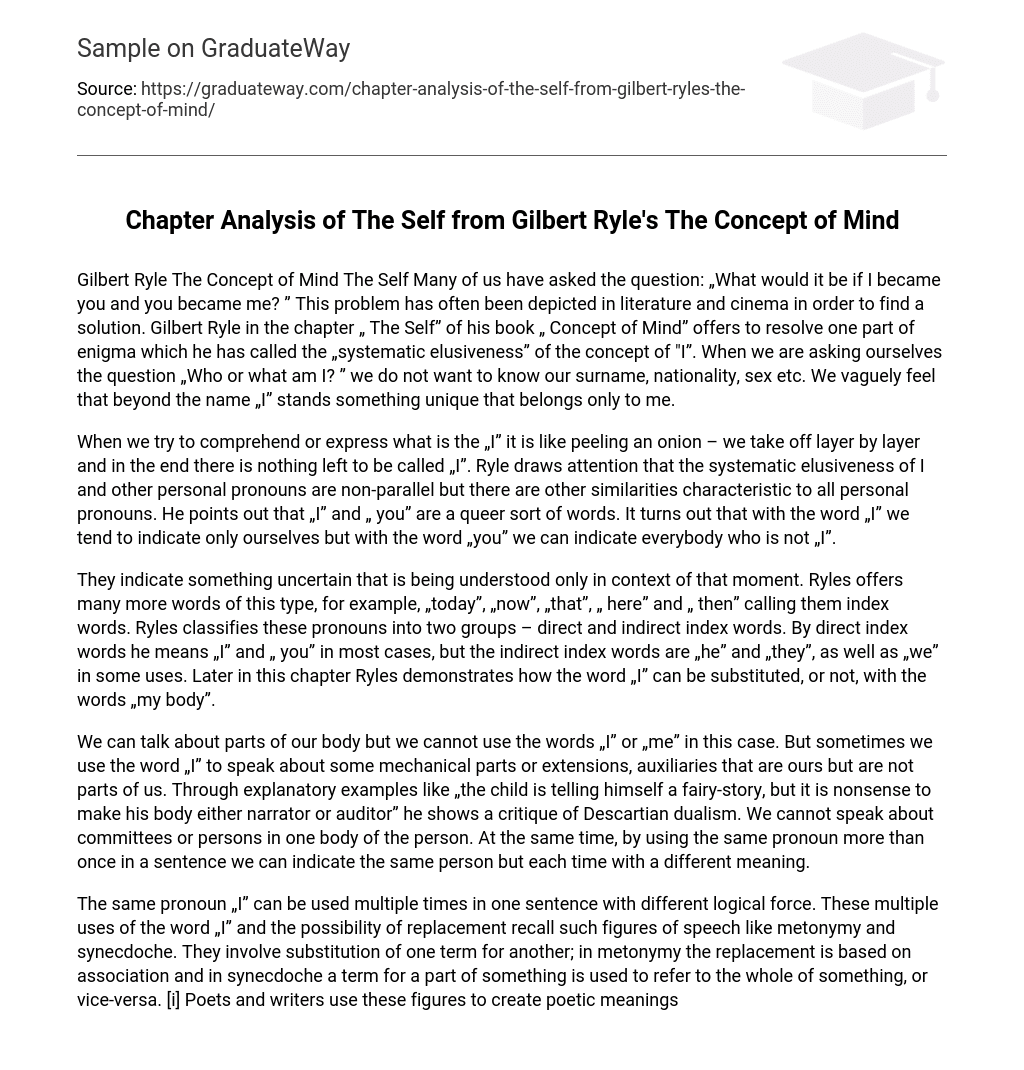Gilbert Ryle The Concept of Mind The Self Many of us have asked the question: „What would it be if I became you and you became me? ” This problem has often been depicted in literature and cinema in order to find a solution. Gilbert Ryle in the chapter „ The Self” of his book „ Concept of Mind” offers to resolve one part of enigma which he has called the „systematic elusiveness” of the concept of “I”. When we are asking ourselves the question „Who or what am I? ” we do not want to know our surname, nationality, sex etc. We vaguely feel that beyond the name „I” stands something unique that belongs only to me.
When we try to comprehend or express what is the „I” it is like peeling an onion – we take off layer by layer and in the end there is nothing left to be called „I”. Ryle draws attention that the systematic elusiveness of I and other personal pronouns are non-parallel but there are other similarities characteristic to all personal pronouns. He points out that „I” and „ you” are a queer sort of words. It turns out that with the word „I” we tend to indicate only ourselves but with the word „you” we can indicate everybody who is not „I”.
They indicate something uncertain that is being understood only in context of that moment. Ryles offers many more words of this type, for example, „today”, „now”, „that”, „ here” and „ then” calling them index words. Ryles classifies these pronouns into two groups – direct and indirect index words. By direct index words he means „I” and „ you” in most cases, but the indirect index words are „he” and „they”, as well as „we” in some uses. Later in this chapter Ryles demonstrates how the word „I” can be substituted, or not, with the words „my body”.
We can talk about parts of our body but we cannot use the words „I” or „me” in this case. But sometimes we use the word „I” to speak about some mechanical parts or extensions, auxiliaries that are ours but are not parts of us. Through explanatory examples like „the child is telling himself a fairy-story, but it is nonsense to make his body either narrator or auditor” he shows a critique of Descartian dualism. We cannot speak about committees or persons in one body of the person. At the same time, by using the same pronoun more than once in a sentence we can indicate the same person but each time with a different meaning.
The same pronoun „I” can be used multiple times in one sentence with different logical force. These multiple uses of the word „I” and the possibility of replacement recall such figures of speech like metonymy and synecdoche. They involve substitution of one term for another; in metonymy the replacement is based on association and in synecdoche a term for a part of something is used to refer to the whole of something, or vice-versa. [i] Poets and writers use these figures to create poetic meanings but it turns out that we perceive ourselves in this synecdochical way in our everyday life situations without even noticing that.
Ryles moves on and starts to explain his idea of „ higher order actions” shifting away from the discussion of different uses of these previously mentioned personal pronouns. By using the description „higher order actions” he does not mean loftier but higher; discriminating the actions by their sequence. Lower actions are the sources of higher order actions, they happen prior to them. If we take the example of parody – we can have a parody of others as well as ourselves, then by mimicking ourselves we exercise the actions of self-consciousness and self-control prior to mimicking.
It means we have to learn both roles -the person being the source of parody and the person who mimics. Ryle gives the well-known example about the student and his singing master – the teacher can mimic the student but not himself; he explains that it is possible to mimic others while the mimicking of ourselves will be slightly different because every sound the teacher says is a new sound so it will be a parody of the source sound as well as a new sound itself.
He is caught up in a never-ending circle of source and parody and there is no real parody as it is seen in the case of mimicking others. In other words – you cannot point to a pointing finger with the same finger and at the same time. It explains the non-parallelism of the notion of „I” and „you” and so we are closer to understanding the systematic elusiveness of the notion of „I”. Ryles here uses the metaphor of a person unable to grasp his „I” of this day because it escapes his grasp when he tries to catch it.
Ryles comes to a conclusion which binds together both ideas of personal pronouns and higher order actions that „when a person utters an „I” sentence, his utterance of it may be part of a higher order performance”. And there is nothing mysterious about the usage of the word „I”. ———————– Online Encyclopedia Wikipedia. Synecdoche. [tiessaiste] Pieejams: http://en. wikipedia. org/wiki/Synecdoche???????????????????????????????????????? [skatits 29. 04. 13} Ryle, Gilbert. The Self. In: The Concept of Mind. USA: University of Chicago Press, 1949, p. 187 – 197





